Vukovar Public Pool to Close Down in the Middle of Summer?
August 4, 2022 - Vukovar's only public pool, the perfect place to spend a summer afternoon, it seems, might not remain one for long. Costs are rising, and the institutions can't keep up. It is not set in stone, but the pools might close sooner than anyone hoped.
As Glas Slavonije writes, it sounds strange because August has just started, so many Vukovar residents and visitors to the city spend part of their free time at the pool looking for escape from the summer heat and a place to have fun and socialize with family and friends, but the news has been verified and it's not just behind-the-scenes stories. Apparently, the city on the Danube has been talking about the closing of the swimming pool for the last ten days. The closing dates have even been mentioned, so you could hear that the indoor swimming pools will only be open until August 15, and the outdoor swimming pools for two weeks longer. Glas Slavonije inquired about the truth of those stories at the Public Institution Sports Facilities Vukovar, whose director Ivan Szabo said that all options remain open.
“We still don't know anything precise. Public tender for electricity and gas is in process, which should end on August 12, and further work will depend on the prices we receive. In general, the situation regarding the payment of energy products is terrible and we will have to react. We will not allow our overhead costs to accumulate for months and thereby increase our debt, and we are aware that we do not have the necessary funds secured in the budget - Szabo confirmed for GS, adding that as responsible people, they must make rational decisions no matter how unpopular or disapproved by the general public.
According to him, at the beginning of the year they started to implement certain savings, but if costs need to be reduced by 10-15 percent while at the same time the amounts they are billed could be many times higher, the savings are not enough.
“Indeed, all options remain open. When we see the results of the tender for electricity and gas, we will take certain steps in agreement with the City. Other institutions and establishments in our city are also faced with the problem of enormous price increases, and it is up to each of them to make the decision they think is the best. I repeat, we will be guided by what is rational, because I believe that accumulating debt that we cannot pay off is not an acceptable option”, he explained.
Closing the swimming pool or reducing its operation, as well as all other facilities offered to visitors, will certainly be difficult for everyone who has been trying for years to position this institution not only on the map of Vukovar, but also on the map of Croatia. It is known that numerous official competitions were held at the swimming pool, water polo and swimming clubs used it for preparations, many non-governmental organizations (especially those that work with children) are regular visitors to the swimming pool, and the number of users is growing year by year. In addition, in case of closure or reduction of the scope of work, it is questionable how the salaries of the employees will be provided.
There is no doubt that the potential decision to close or drastically reduce their volume, which at this moment seems completely realistic, presents a series of questions to the authorities that must be addressed in due time. Those who have been closely following the events in Vukovar in recent months will not be surprised by the (temporary) closing of the swimming pool. GS reminds that Mayor Ivan Penava recently told his fellow citizens that they have decided to return to the model of trying to defend the positions of the City, in terms of protecting the living and social standards of citizens, which - as he emphasized - will be extremely difficult.
It was announced that after the reduction of public lighting, more radical savings measures can be expected, without excluding the possibility of reducing and suspending the work of certain institutions and establishments.
For more, check out our lifestyle section.
Water Tower Race Vukovarskih 198 to Finish on Top of Famous Monument
August 4, 2022 - Vukovar is fast becoming the place to go for events and activities. After an eventful summer, it will welcome autumn with a unique sports event, a Water Tower race. To date, more than 150 participants have registered.
As Glas Slavonije writes, the Vukovar Athletic Club is organising a race up the stairs of the Vukovar Water Tower called Vukovarskih 198 (The Vukovar 198).
The name of the race is due to the fact that the Water Tower has 198 steps, and each competitor will also run 200 meters of the memorial path, which means that the finish line of the race will be at the top of the famous structure in Vukovar. Daniel Lovrinović, the secretary of the Vukovar Athletic Club, who runs recreationally, is the initiator of this specific race.
“Every morning I get up at five o'clock and go for a run before work, because I consider it mental hygiene. As I’ve regularly passed by the Water Tower, even while it was being renovated, I thought it would be interesting to organize a race in it. I have participated several times in the "Zagrepčanka" race in Zagreb, and running up the stairs fascinates me. As far as I know, no race has been organised in a monument such as the Water Tower, and I believed that it would attract a large number of participants”, Lovrinović told us, explaining that it is not only important to organise the race for its own sake, but also to promote the Vukovar Athletic Club, which started working actively with children this year, and will soon have activities for recreational athletes.
The organiser's wish is that Vukovar benefits from the race, because those who come from outside the city will stay for a day, two or three, which means that they will sleep in Vukovar, maybe try some local specialties, visit museums or other interesting locations. Ultimately, it will help the promotion of the city on the Danube. All those interested can apply online until August 31, and Lovrinović pointed out that more than 150 participants have registered so far out of 240, which is the maximum number.
“We cannot accommodate more runners because the Water Tower is open and we managed to reserve it for the race on September 17 from 8 am to 1 pm. We want the race to become traditional. So far, we’ve had applications from many Croatian cities, literally from Vukovar to Dubrovnik, but also from abroad - France, Bosnia and Herzegovina, and Germany. The principle of the race itself is quite simple. The second runner will follow 60 seconds after the first, and when the eighth competitor reaches the top of the Water Tower near the flag, we will take a minute or two break, until the first seven reach the elevator that will take them down. When they reach the elevator, the next runner will start and so on until everyone has completed the planned course”, he explained.
This is the minimum start time difference between participants because the staircase is narrow and it is not possible to get around the runners in front who may need more time to reach the top.
For more, check out our Lifestyle section.
Klein Film Festival for an Exciting Summer Weekend in Vukovar
July 29, 2022 – think of Croatia in the summer. Fun in the sun, refreshment in the shade, perfect swimming temperatures, and a sandy beach. All that followed by a night out at a film festival, craft beers and some quality rock music in the forest. Dalmatia or Istria? Surprise surprise, and once again, welcome to Vukovar! We got your weekend sorted.
This Friday, Saturday, and Sunday, the Bara Film Association as the organisers of Klein Short Film Festival are bringing something unique and exciting to the venues, pubs, and parks of Vukovar. The event of the weekend from the 29th until the 31st of July combines short films and good music for the perfect summer atmosphere.

The program for the competition section of Klein Film Festival (photo credit: Klein)
Kicking off on Friday at 20.30 at the City Museum, this international film and music festival presents a variety of short feature, animated, and documentary films. The films were split into two main categories – competition and accompanying programs, with 16 and 35 films, respectively. The category of competition films will feature pieces produced in the last two years, while the accompanying program will consist of representative pieces produced before 2020. The venues include the City Museum and the Serbian Cultural Centre in Vukovar, as well as the Đorđe Očić House in the village of Dalj. The organisers underline that the main focus of the festival is the idea, along with its consistent realisation in the film. The name of the festival is an homage to Hugo Klein, a theatre professor, theorist, and psychiatrist who was born in Vukovar.
As for the music portion of the festival, there will be something for everyone. The pub Kibic Fenster is opening its back terrace for mini-concerts, while the park forest Adica will host some big names. On Friday, Sinj’s own Mort will be there to remind us that punk is not dead, on Saturday it’s Repetitor, and to round it up, Atheist Rap from Novi Sad will play on Sunday. All concerts start at 22.30.
The main sponsors of Klein Film Festival include the City of Vukovar, SDF (Serbian Democratic Forum), and HAVC (Croatian Audiovisual Centre), and the association also expects international support. Bara Film is a young cultural association of audio-visual artists who hope that this ambitious project will help further support and enrich their work.
For more, check out our lifestyle section.
Meet Vukovar 365, Full of Life - Luka Maksimović Mone
July 28, 2022 – Meet Luka Maksimović, also known as Mone, also known in Vukovar as your go-to wall decorator, logo designer, the guy who can make your ideas come alive in visual form.
Long before there were murals and 3D street art, there was graffiti. This art of old is as present in Vukovar as anywhere else and was even integrated into festivals and events. From simple writings notifying us that they were, in fact, there, to some really elaborate and genuinely awe-inspiring designs, we have it and we love it all.
As for graffiti artists, it sure can be tricky as they always must defend the artist title, trying not to fall on the rebel and destroyer-of-walls side of things. This means that they constantly need to keep improving to impress. Mone has done just that. From the name that you would see a little too often in your neighbourhood, to being commissioned to paint walls and design logos, he has gone from naughty to nice, from kid to artist. We couldn’t be happier to follow along on his journey.
All photo credit: Mone
Tell us about yourself and your alter ego.
I am Luka Maksimović Mone and I'm 24 years old. The nickname was created to hide my identity and it was created through the evolution of nicknames that came from my last name: Maksimović - Maxo - Maxone – Mone.
What is your relationship with art?
My story on drawing starts back in kindergarten, where I had a friend who was great at it. I remember one day when we had a workshop and he drew the Hulk too well. That stuck in my memory and inspired me a lot. At home, I spent time drawing whenever I could. I practiced with my brother, drawing various objects that we could see on the table. Later on, I started drawing portraits, but realism as a direction did not satisfy me. The way I see it, you can just snap a photo.
Drawing quickly became a bit hard and boring, and since I'm a bit of a perfectionist I was by no means satisfied. One day we tried drawing graffiti and that was my first encounter with this kind of art. I remember that I chose the English word "book" and made eyes out of the two letters O and added a mouth below. This was completely new and exciting for me. I started using letters to create all kinds of shapes that came to mind.
Was that when you discovered your hidden talent?
That was when I discovered there were no rules, I could do whatever I wanted, in any style I liked, any size, form, or shape. It all came straight from my head, and luckily I was never short of ideas. As for talent, I wouldn't say that I discovered my talent there or that I am talented at all. I just spent a lot of time at my desk drawing, simply because it was too much fun.
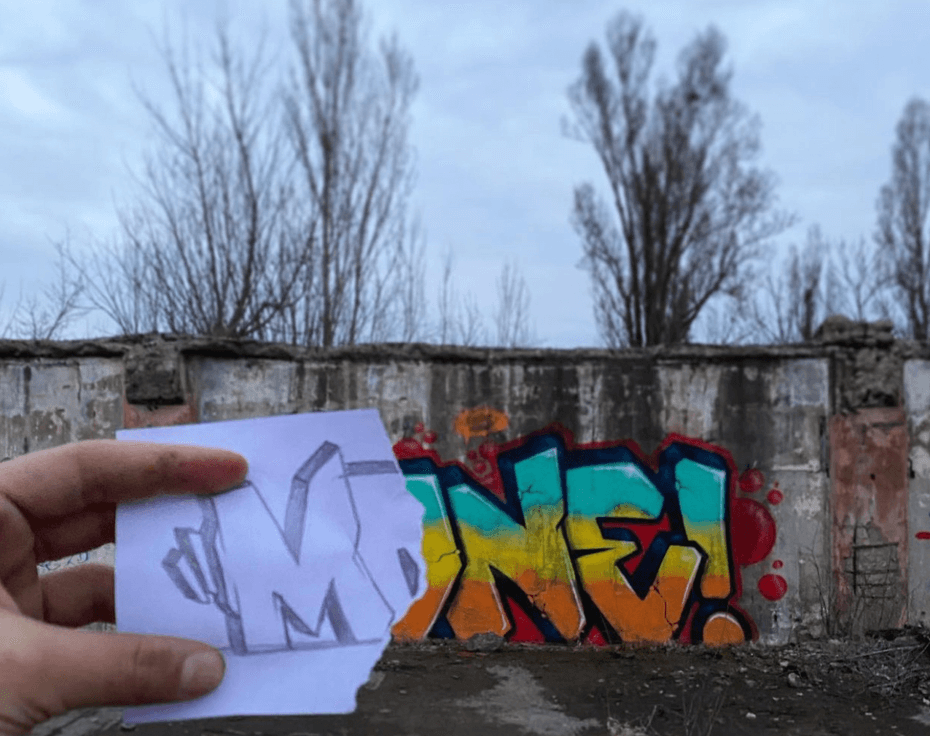
At which point did you go from paper to walls?
Soon after, my brother and I decided to try our first real graffiti. We found a wall and prepared everything, but we weren’t quite ready for the little obstacle that was me. I was too small and couldn't do it! My hands were too small, I couldn't hold the spray and squeeze the cap with one hand, I could barely do it with two hands. That was frustrating and caused my desire to slowly fade away and over time I completely neglected drawing. All until one time, in 3rd grade, during math class, I was so bored I wanted to jump out of the window. Instead, I remembered that I had used to draw graffiti all the time and decided to try it again. As soon as I drew my first lines it took me back. I felt like that child, like I was drawing for the first time. I was really happy with the sketches I made. A few days later, I bought a spray can and finished my first graffiti on the wall. I was intrigued and wanted more. It felt like I went back in time and simply continued where I had left off.
Eventually, you decided to do it in digital form.
While traditional graffiti wasn't bad, it wasn't anything special, and I knew I could do better. I started taking it more seriously and wanted to improve. After trying a few different techniques, I realised I needed a lot of money for the material and ran into a problem. So instead of buying markers and other things, I saved up to buy a tablet for graphic drawing which allowed me to switch to the digital canvas, where I had the best palette in the world, an inexhaustible source with every color imaginable. My mind was made up about what I wanted to do in the future.
What is the plan from here?
I am developing my project and plan to open a graphic design company and some other interesting things along with that. As the idea to open my own company developed, I also fell in love with tattooing. I recently bought a tattoo machine as well, so that will surely become a part ofg my workshop.
Tell us about your clients and projects so far and where we can find you.
I collaborated with various people as a freelancer, creating their visual identities. In Vukovar, for example, I collaborated with the fire department and one of the kindergartens. I also did a few projects with famous people such as Krešo Bengalka, Kukus clan, etc.
To check out my work, follow me on Instagram (@mone1zm).

Finally, how is the graffiti scene in Vukovar?
A graffiti scene barely exists here at all, as I'm the only one who does that. However, the city of Vukovar does push for street art a lot through the VukovArt organisation, who have brought many famous street artists from around the world to paint murals on buildings and create 3D street art.
All photos by Mone
For more, check out our lifestyle section.
Duchess of York, Vukovar County Officials Discuss Humanitarian Projects
ZAGREB, 12 June 2022 - The Duchess of York, Sarah Ferguson, on Saturday visited the eastern Vukovar-Srijem County, where she discussed humanitarian projects of the Montessori Group and integration of Ukrainian refugees with local officials, the county authorities said.
The Duchess of York is visiting Croatia from 9 to 12 June as chief ambassador of the Montessori Group to promote its work, with emphasis on the integration of Ukrainian refugees in Croatia and new forms of cooperation in providing support to children around the world.
She informed county officials of her humanitarian work and wish to extend it to include Vukovar and Vukovar-Srijem County, notably refugee children from Ukraine, which they welcomed.
The Montessori Group has been providing education and support to teachers and other individuals caring for children in the region of Banovina, hit by an earthquake in 2020.
The group is a global leader in support to quality education, and devising programmes of support to Ukrainian mothers and children envisaging inclusive kindergartens is one of the main reasons why cooperation with the Duchess of York was established, the county authorities said in a statement.
Developing a model that will enable Ukrainian mothers to find a job and start rebuilding their lives in the new country, knowing at the same time that their children have adequate daily care and education, is a shared vision, the county authorities said.
For more, make sure to check out our dedicated lifestyle section.
Vukovar-Srijem County Sends Humanitarian Aid to Ukraine
ZAGREB, 6 June 2022 - On Monday, 16.4 tonnes of humanitarian aid worth HRK 247,311 (€33,000) collected by Vukovar-Srijem County in cooperation with cities and municipalities in this eastern Croatian county was sent from Vinkovci to Ukraine.
At the initiative of County Prefect Damir Dekanić and with the support of the Embassy of Ukraine in Croatia, Vukovar-Srijem County organized the collection of aid for the friendly Transcarpathian region, mainly durable food, baby food, water, and cosmetics.
"We are a region that has experienced the horrors of war in the worst way and it would be sad if we did not recognize someone's suffering. We have accepted refugees from Ukraine since day one and we are ready to continue to do so, but we hope the war in Ukraine stops," said Vukovar-Srijem County Prefect Damir Dekanić.
According to Dekanić, the campaign, led by the county, was joined by 17 Vukovar-Srijem municipalities and the cities of Ilok and Otok. The county provided HRK 142,751, while cities and municipalities contributed HRK 104,560.
For more, check out our politics section.
Best Beaches in Slavonia - Freshwater Paradise
May 12, 2022 - Summer is on the horizon, temperatures are higher and people are already planning how to cool down in the coming hot months. Unfortunately, not everyone can afford or reach the Adriatic coastline for much-deserved relaxation. However, Croatia has countless beautiful rivers and lakes used for swimming and recreation and Slavonia is full of those. A look into the best beaches in Slavonia.
As mentioned before, some people living outside of regions located near the Adriatic coast can’t afford or travel great distances for the ultimate Croatian summer. Because of those limitations, people needed to find ways to cool themselves and relax in their cities during unbearably hot months. Slavonia is definitely one of those regions. Older Slavonians will remember those summers decades ago when only a few families could afford to go to the Adriatic coast, after saving money all year, and others “less fortunate ones”, would go to rivers and lakes near their hometown. Those swimming places were made up on the go - “beaches” were mostly covered with untouched nature and unexplored terrains. Let’s just say they weren’t particularly safe but after a few accidents and realizations that structured swim places can be profitable and safe havens for families with kids, local authorities started investing in swimming and recreational infrastructure on those lakes and rivers. Water quality began to be reviewed for swimmers and after tests showed that the quality is excellent, the building could start. Without further ado, these are the best beaches in Slavonia.
“Copacabana” on Drava River in Osijek - “Kopika”
The list of best beaches in Slavonia starts with non-other than “Kopika”. One of the most popular river beaches in Slavonia, this is one of the swimming places in Slavonia that you can’t miss. Beach that offers views of iconic places in Osijek like Tvrđa, co-cathedral of St Peter and St Paul, Hotel Osijek, and the Bridge of Youth? Amazing. Since 2020, the beach and recreation center went through a lot of renovations and “Kopika” will shine in its new guise this summer. Modern pools, showers, cabins, and many more, make this beach unmissable this summer.
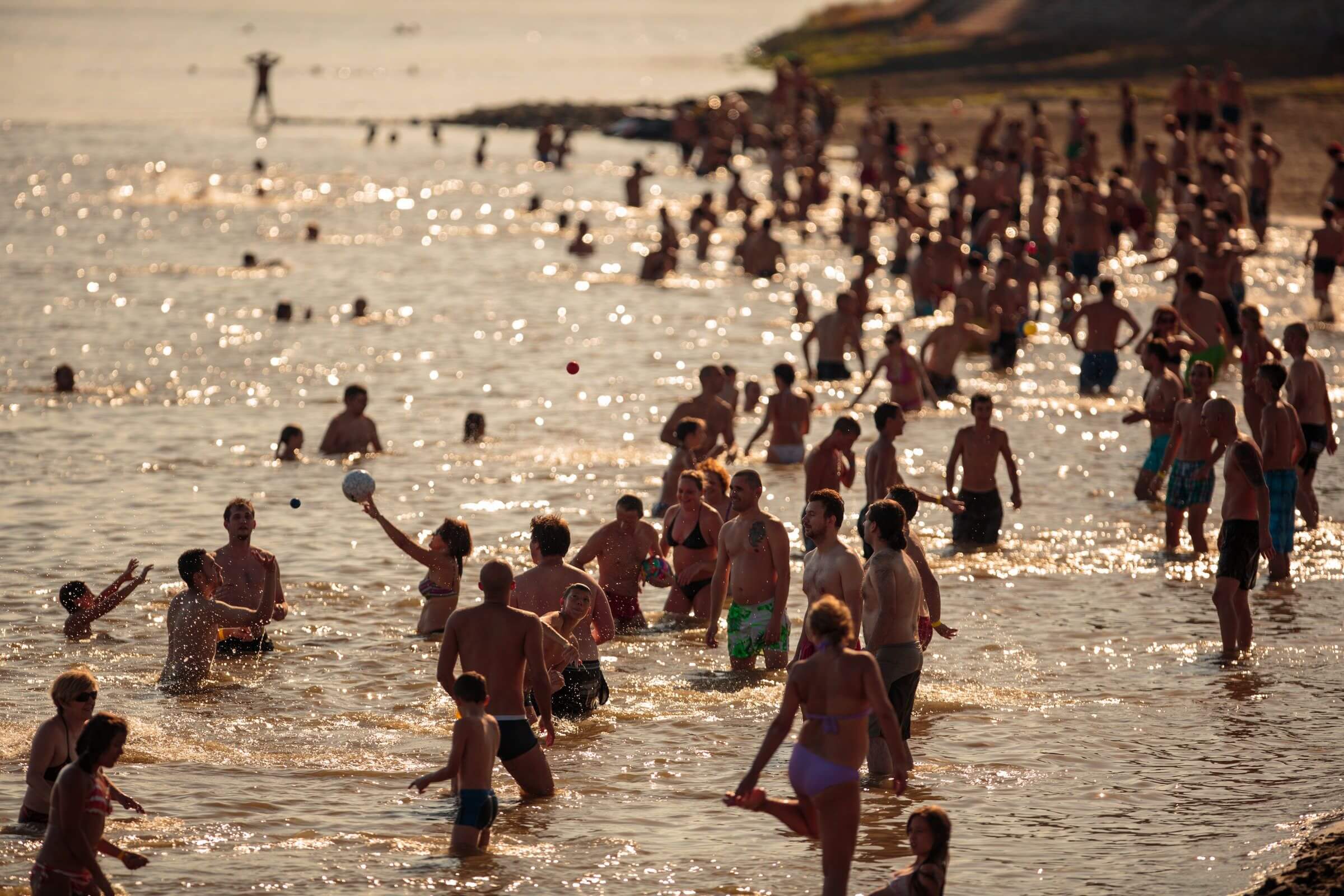
"Kopika" beach in Osijek (image credits: Mario Romulić)
Križnica Island on Drava River
This island is located on the Drava River near the small town of Pitomača, the westernmost municipality in Virovitica - Podravina County. Once the border between the Kingdoms of Croatia and Slavonia, this ancient island was the last one in the historic Pannonian Sea and its sandy beach attracts swimmers and recreationalists all over the country. Its bike routes, local cuisine, and natural private retreat make this river beach one of the best in the country and it’s an unmissable place to visit for refreshments and relaxation.
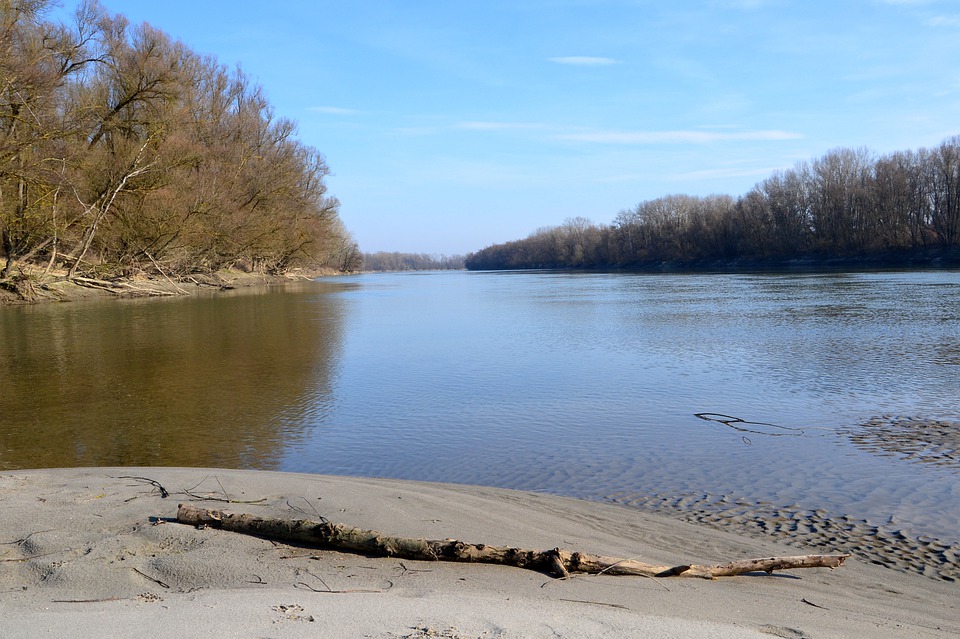
Križnica Island on Drava River (image credits: glaspodravine.hr)
Poloj Sports and Recreation Center
Apart from the Drava, the Sava River and its Poloj beach takes the crown as one of the most beautiful beaches in Europe. During summer, this beach attracts plenty of swimmers in need of refreshments. The white sand beach that can compete with some on the Adriatic coast, offers a lot of content - sandy fields for volleyball, futsal, places for barbecue, bike and pedestrian routes, and many more. Slavonski Brod and its surroundings is an amazing place for Digital Nomads and other tourists because it offers everything for everyone. So, visit this amazing place during summer, you won’t regret it.

Beach Poloj on Sava River, Slavonski Brod (image credits: Alen Vrlazić/tzbpz.hr)
Lakes Banja in Vinkovci
Once upon a time, these two artificial lakes had different usage. More precisely, it was used for clay excavations for a brick factory back in the day and only brave men would go and swim there. However, in 1997, the realization of the potential these lakes have for sport, recreation and relaxation hit, and since then, Lakes Banja became a popular swimming place for residents of Vinkovci. The amazing quality of water and clean and tidy beaches are a perfect place for fishermen and people who want to have a proper swim. After that, barbecue, beer, and an amazing time.
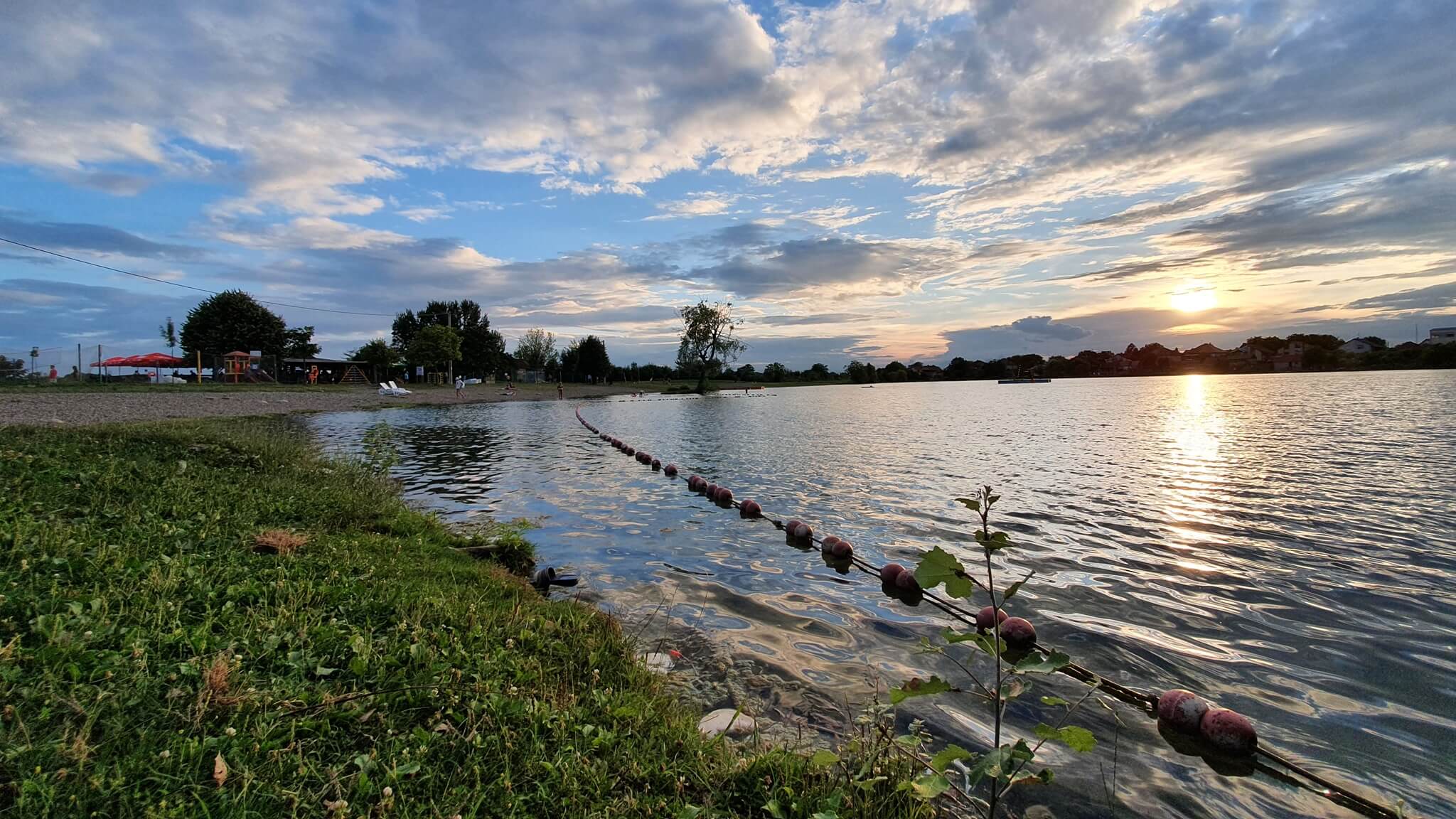
Lakes Banja in Vinkovci (image credits: Banja Vinkovci/Facebook)
Ada Island on the Danube River in Vukovar
Ada is a beautiful Croatian river island on the Danube River covered in a sandy beach and it’s a favorite swimming place in the city of Vukovar. Only 10 minutes away from cities center by boat and ranked among the ten most beautiful and interesting beaches in Croatia located along rivers and lakes. All those interested in peaceful vacations or maybe active vacations and adventures will surely find something for themselves. Amazing tourist offer that includes boat tours, volleyball on sand, and a gazebo full of refreshing drinks under the shade of the forest, makes this one of the best beaches in Slavonia.

Residents of Vukovar playing beach volleyball on Ada Island (image credits: Branimir Bradarić/lokalni.hr)
Lake Orahovica near village Duzluka
Only 1500 meters away from the historic town of Orahovica, this artificial lake is probably the only proper place to swim in its radius. Last year, this famous lake celebrated its 60th birthday and it’s not stopping soon. This lake is a magnet for fun. From the most popular music festival in Slavonia Ferragosto Jam to the rich recreation offer, Lake Orahovica is an unavoidable place to visit and what’s also really important to mention, its water comes from the mountains! Besides its clear natural water, location is idyllic - just at the foot of Papuk Mountain and the historic fortified city Ružica City that, according to one legend, was a gathering place of fairies. It’s truly looking like a fairytale from Ivana Brlić-Mažuranić novels indeed.
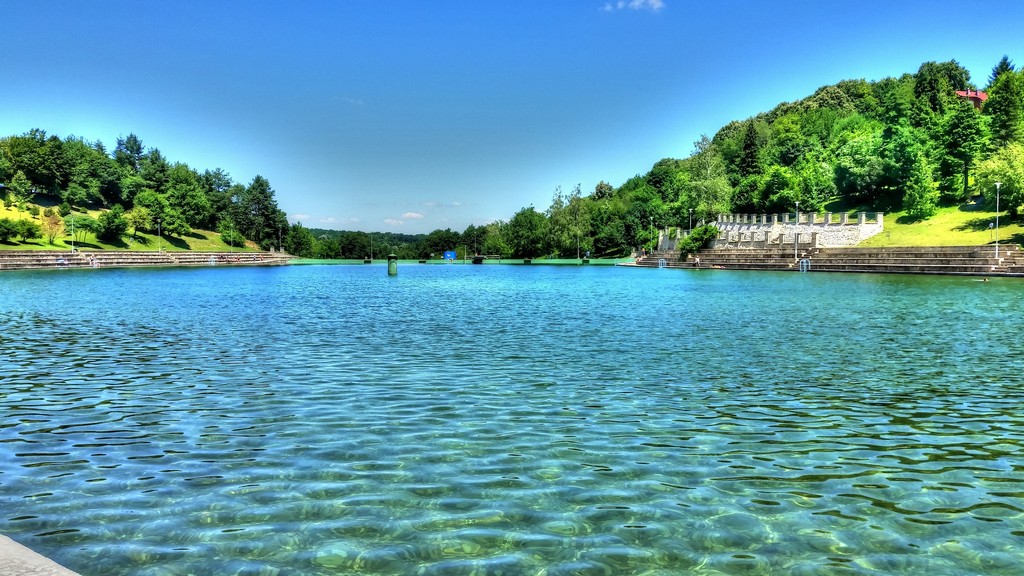
Lake Orahovica is surrounded by historic sightings and mountains (image credits: orahovica.hr)

Ferragosto Jam brings the best of Croatian music every year to Lake Orahovica (image credits: screenshot/ferragostojam.com)
Honorable mentions are recently officially opened for swimmers Bajer Lake in Đakovo, Lake Borovik located west of Đakovo, natural Lake Đola in Darda near Osijek, beaches in Batina and Aljmaš where Drava River flows into Danube River, Lake Petnja, northwest of Slavonski Brod and so many more.
All of these places are rooted in Slavonians' lives. Great tourist offers and safe place for families, makes river and lake beach a must-visit during this summer. Yes, summers in Slavonia can be more insufferable than in, for example, Dalmatia (different climate), but for that, these freshwater beaches make every hot summer durable. Furthermore, it makes it the most anticipated season in Slavonia. Hopefully, this list of best beaches in Slavonia will encourage tourists to come - Slavonians will welcome you with open arms.
For more, check out our travel section.
Science Festival Vukovar to be Held for the First Time
May 6, 2022 - This week, for the first time, an event aimed at bringing science closer to the public, the Science Festival is being held in Vukovar.
The Science Festival is an event that has been held in Croatia since 2003 with the aim of bringing science closer to the public by informing about activities and results in the field of science, improving public perception of scientists, and motivating young people to research and acquire new knowledge, reported Sudarić, dean of the Vukovar College of Applied Sciences.
"We brought this event to Vukovar precisely to encourage our young people, especially children attending kindergarten and primary school to do science and introduce them to the idea that science is very important. We are witnesses that during the pandemic, scientists were key, they were the ones who had to find a solution to end it", said Sudarić.
The longing for expansion of knowledge and encouraging innate curiosity in all ages are valuable goals of the Science Festival, which will take place in Vukovar on 6 and 7 May. As part of this event, more than 40 activities will be carried out at four different locations, some of which are open to the general public.
"The festival will be held at four locations - the Vukovar Gymnasium, the Vučedol Culture Museum, the Vukovar City Museum, and the "Lavoslav Ružička" College in Vukovar, where all fans of science and those involved in it, depending on age, will be able to expand their knowledge of life because it is the central theme of this year’s Science Festival. We have a lot of activities this year, the first year of the festival in Vukovar. I must admit that when we started the event, we thought that there would only be three or four registered activities", said Dean Sudarić.
The Vukovar Festival is the result of cooperation between the Vukovar Gymnasium, the Vučedol Culture Museum, the City Museum in Vukovar, and the Lavoslav Ružička College in hopes that Vukovar will receive its place on the map of the Festival and become part of this scientific event, says Sudarić.
For more, make sure to check out our dedicated lifestyle section.
History of Vukovar or History in Vukovar? No, Our Future Please
May 3, 2022 – Vukovar is indeed full of life. The 3rd of May is Vukovar Day, marking the day it became a free royal town in 1231, and the day of Saints Philip and James who became Vukovar’s patron saints when their church was built in 1723.
Traditionally, this day is a bank holiday in Vukovar, with celebrations and events in the city centre. With the Svi zaJedno Hrvatsko Naj festival leaning onto Vukovar Day, the city becomes the site of culture, sports, gastronomy, music, and more, for over a week. And if you take a closer look, you will see that it’s Vukovar’s youngest who make the city come alive. The little ones are jumping with joy and running between the stalls, the decorations, and the popcorn vendors, and our high schoolers are even here to teach us something. And if you listen closely, you can hear them speak both Croatian and Serbian.
Courtesy of TZ Vukovar / Marko Balaži
This co-existence in Vukovar still sparks debate among those who know about its history, and curiosity among those who are yet to learn. On this Vukovar day, we decided to have a look at history in hopes of making a step in the right direction for our future. We went to schools in Vukovar, both primary and secondary, where we had a chance to speak to the headmasters and teachers. The guiding thought was the idea that the subject of history is a sensitive area, especially in Serbian minority classes. This question has been explored before, with varying conclusions, so we wanted to see where we stand in 2022. The outcome is interesting, but not surprising, refreshing, and yet completely normal.
The demography of Vukovar
Vukovar has historically been a diverse urban centre, whose population throughout the 20th century was made up of the Croatian, Serbian, Hungarian and German nationalities to varying extents, with the Serbian population steadily growing and reaching 25,5% in 1948 and 32,3% in 1990, whereas the German and Hungarian population significantly declined during the same period. In 1990, the Croatian population made 47,2% of its 44,639 inhabitants. It is important to note that the social structure of the city kept changing throughout the 20th century due to the Yugoslavian policies, as well as the fact that the socialist state discouraged expressing religious beliefs or national identity in everyday life. Our interlocutors who have lived all their lives in Vukovar shared that in pre-war Vukovar “you wouldn’t know other people’s nationalities or beliefs” (I.A., 68), “unless in a political situation, no one cared” (A.J., 63), “in everyday human lives it did not matter one bit, we all played together as kids, grew up together and watched our children grow up together” (J.G., 72). Their memories of the city make their faces light up and their eyes sparkle, and they happily share stories of life by the river, the best ice cream, friendship, and family. The things that mattered. Of course, the events of 1991 shattered that image of the city and it took decades to start even imagining something like that again.
"The Danube Bath", courtesy of Vukovar Municipal Museum
Model A for the education of national minorities
Like anywhere else, the rights of national minorities in Croatia are emphasized and respected in all aspects of life. One of the areas serving as a constant source of inspiration for debate in Vukovar is schooling. In Croatia, schools follow a three-model system (A, B, C) with several additional programs (such as summer school ). In model A, minority language and writing systems are fully adopted, with the Croatian language taking an equal amount of school hours as the minority language. Model B uses both Croatian and minority languages, with social subjects taught in the minority language. Model C teaches minority languages and cultures as an additional subject, with all other instruction and teaching done in Croatian.
In Vukovar, models A and C are most often chosen by minorities, with model A being the most likely choice of the Serbian national minority. What this means is that schools following model A will often have students of the same age group take separate classes based on the chosen model (i.e. if they are a member of the minority group or not). The purpose of the three models is the preservation of minority languages and cultures with enough flexibility to accommodate for integration.
Peaceful reintegration of the Danube Region and the history moratorium
One of the conditions of the Serbian representatives in the peace negotiations of 1997 was that there was a moratorium put on the teaching of Vukovar’s recent history in national minority classes. The moratorium lasted 5 years and officially ended in 2003. From 2003 to 2022 it has been a rocky road, and there were numerous attempts to have a peek behind the scenes and see if the sensitive parts of history are being taught in minority classrooms. Sensationalist headlines would appear, stating that Croatian history is only taught over something like 3 pages in the Serbian textbook written in Serbian using the Cyrillic writing, that teachers deliberately skip and ignore the whole section, that they twist it, etc. Having spoken to headmasters, teachers, parents, and students, the truth is simple – it is highly individual, and if teachers feel strongly about the topic, they might be inclined to adapt their way of teaching. The opinions of parents are varying, some feel strongly, and some don’t, depending mostly on the generation they belong to. What probably sums it up best, are the words of the mother of a second-grader, stating that “we cannot avoid the topic, certainly not in 2022. No matter which classroom my children attend, they will learn about the events and hopefully, they will be able to form their own opinions. What we want for them is to live a normal life and grow up in a society of equal opportunity”. (S.G.)
The headmasters of primary schools and secondary schools all agree that they are currently facing much bigger issues, some caused by the pandemic, some by the modern way of life, but that history on this or that side has become a rather dry topic which is not in their control anyway. They emphasize that having started from completely separate classrooms, teachers, subjects, and extracurricular activities, students these days all play together, attend workshops and sports clubs, take part in competitions and plays, and even go on excursions, exchanges, and cultural events together, forming separate groups around things like celebrity crushes, candy or games, and not nationality.
Like it or not, Vukovar is healing as nature always finds a way
The honest truth is it has been 30 years and time and nature have started doing their thing. A change of generations has happened. Make no mistake, what happened in Vukovar in 1991 were inhuman atrocities that can never be denied, and there is a lot of injustice still making it that much harder even after 30 years. Unfortunately, those who deserve punishment might never be punished for the crimes they committed but let us not punish those who had nothing to do with it, those who are at the same time the future of our city. Children are children, they might grow up to become assholes or they might go on to save the world. They might learn history in Croatian written in Latin writing, or that could be Serbian in Cyrillic writing. Chances are, they will find it equally boring and would much rather play than study. Some might be fascinated by it. They are all different. We are all different. Maybe it’s time to start learning from the young ones and celebrate diversity while working together for a better future for all of us. 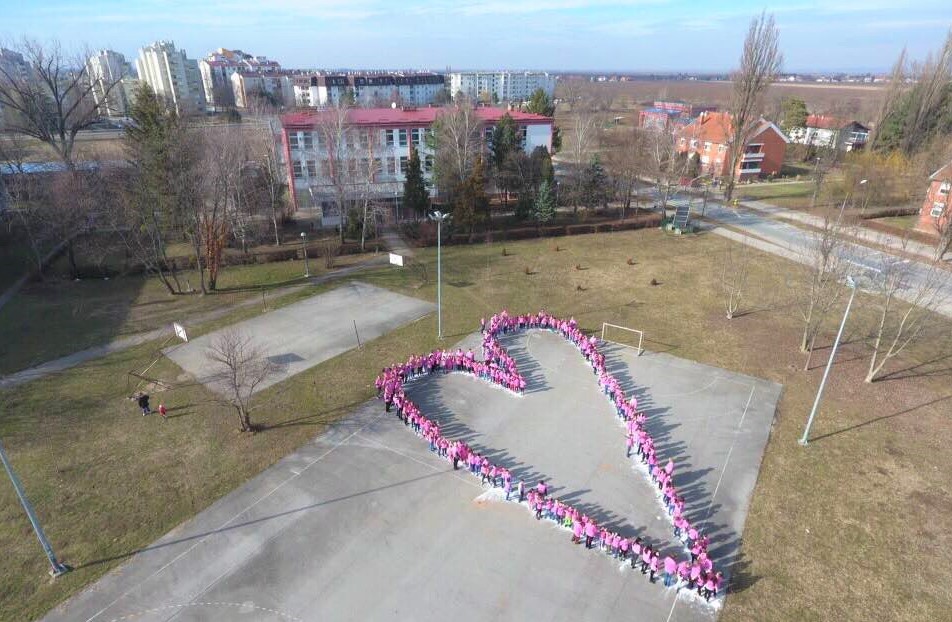
National day against peer violence, courtesy of OŠ Siniše Glavaševića
For more, make sure to check out our dedicated lifestyle section.
From Požega to Ilok: Best Bike Tours in Slavonia
24th of April 2022 - A few days ago, the world commemorated Earth Day, so it’s only convenient to present one of the most ecological and recreational ways of transportation - bikes, or in this case, bike tours. A look into the best bike tours in Slavonia.
Spring is in full swing which means a yearly reminder of recreational tourist offers Croatia, or in this case, what Slavonia has to offer. Bicycles are a huge part of Croatian lives. Bike clubs, amateur cyclists, and regular people who want to be part of these events became more and more frequent and stayed part of these movements and events. Of course, with every recreation or hobby, there’s always a potential for tourist opportunities. For example, Dalmatia with its already diverse tourist offers incorporated bike tours, which suit really well with the geographical location of the region. Hilly and somewhat mountainous terrain with the scent of sea salt and a view of the Adriatic Sea, attracts every tourist who wants to experience the beauties of the Dalmatian region recreationally. Even islands like Brač, Hvar, and Korčula where you can transport your bikes with catamarans, have various offers of bike tours. Istria does an amazing job as well and northern Croatia with Međimurje, Zagorje, and Zagreb regions attracts more and more bike lovers every year!
However, the full circle couldn’t be rounded without the region of Slavonia which is doing an amazing job in promoting its land and presents new and creative tourist offers every single year. From Požega and its Golden Valley to the wine roads of Srijem and Baranja, bike tours in Slavonia could easily have one of the best tourist offers in Croatia. So, without further ado, let’s start with the best bike tours in Slavonia.
Vinkovci, Vukovar - Srijem county
If you want to explore Vinkovci and surrounding places a bit more adventurously, definitely consider these available trails which stretch through the whole Vukovar-Srijem county. There are a few different types of surfaces available - macadam, earth, gravel, grass, and asphalt, which are intended for riding mountain or other types of quality bikes. The trails are marked in blue, red and yellow and they all have one thing in common - the bridge on river Bosut in the center of Vinkovci which is the start of every bike trail. The blue trail is 19 kilometers long and leads from Vinkovci to the village of Borinci to a rural home called “Antin Stan” in Ivankovo and back to Vinkovci. The red one is 15 kilometers long, moving the new dam on Bazjaš canal to the Kunjevci forest and back to the center of Vinkovci. Last official trail is marked with yellow color and is the longest, around 21 kilometers, stretching from bridge on Bosut towards rural house and picnic area Sopot in direction of Rokovci. After that, the trail continues to Kunjevci forest and back to Vinkovci. If you’re ever interested in trying these bike tours, contact the Vinkovci Tourist Board for maps of these routes here.
 Colorful bike tours in Slavonia around Vinkovci, (Screenshot: Master plan grada Vinkovaca za promet)
Colorful bike tours in Slavonia around Vinkovci, (Screenshot: Master plan grada Vinkovaca za promet)
Apart from these official bike trails, there are a few routes that go further in Vukovar-Srijem county:
- Danube cycling route (EuroVelo 6) - This one passes along the Danube River and its length is 138 kilometers in Croatia. Probably one of the most popular bike routes in Europe cuts through Vukovar-Srijem county, connects with cycling route Srijem and continues toward the Black Sea. The route can be checked here.
- Srijem route - Connects the southern area of Vukovar-Srijem county with the northeastern part. Its starting point is the center of Vinkovci near the popular Lamp and goes through Rokovci, Andrijaševci, Cerna, and Gradište towards Cvelferija (9 villages of Županja’s area) then through Gunja, Vrbanja, and Drenovci to the city of Otok.
- Route Otok - This bike route offers two possibilities: the first one is a ride across Privlaka to the city of Vinkovci and the road from Nuštar and Bogdanovci to Vukovar while the other route is going through the village of Komletinci to Nijemci, towards Tovarnik and Ilok.
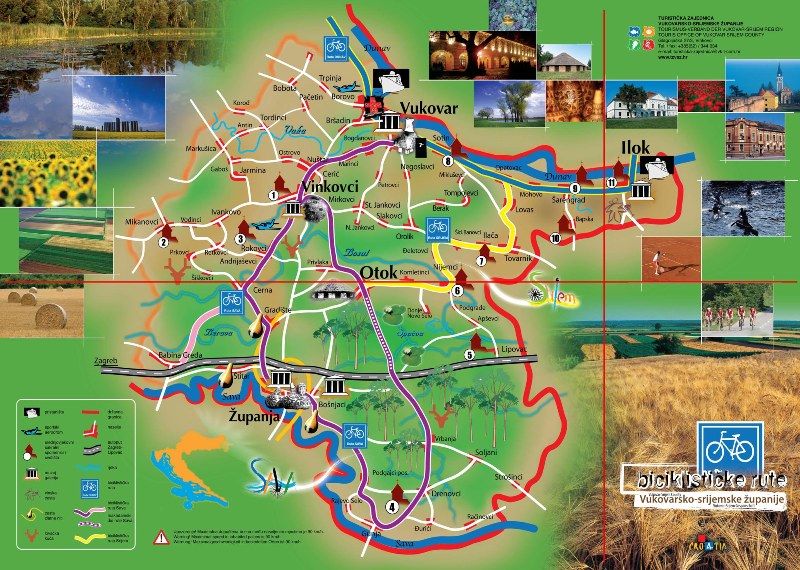
Route Otok and Srijem with other bike tours in Slavonia around Županja area, (Screenshot: tz-zupanja.hr)
Even though the area of Vukovar-Srijem County seems small, it has a lot to offer. Golden fields of wheat and sunflowers that have been just planted, sun in the sky, multiple options for eating and drinking, and most importantly, the people. If you need quick transport, buses and trains are available - most of the time.
Osijek, Osijek - Baranja County
Besides already mentioned EuroVelo 6 Danube River route that goes through Osijek and its county as well, there is the Greenway Cycling route that connects Croatia and Hungary with the goal of cross border relations, building up tourism and eco-tourism in the area along the Danube-Drava Rivers. There is already a great piece on our dedicated to cycling Total Croatia Cycling site, about the Greenway route and the whole project that took place in 2016. You can read it here.
Another European bike route goes through Slavonia - EuroVelo 13 or “Iron Curtain Trail”. The name stems from the fact that the border was part of the infamous “Iron Curtain”. Beautiful landscape, pristine forests, Drava River in all its glory, and of course gorgeous cities along the way - Beli Manastir, Belišče, Valpovo, Donji Miholjac, Koprivnica, and many more. Of course, great food and drinks for relaxation. For more information about this route, check here.
When it comes to cycle tourism, Osijek and Baranja regions are top-notch. It’s not a surprise that Osijek has the most cycle paths in Croatia which spread through the whole city. If you own a good bike and love cycling moreover public transport, Osijek is a great city for you. Here are a few suggested bike tours exploring Osijek and its surroundings:
- OSIJEK - UŠĆE KARAŠICE - OSIJEK: This route starts from the city of Osijek and goes to Višnjevac. After that, there is a wooden bridge towards the west that continues through beautiful forests and natural landscapes near the Drava River. The route stretches all the way to fishing house located on mouth of Karašica and Drava rivers. The length of the route is around 20 kilometers and it’s not particularly complicated. Suited for mountain and track bicycles. You can check the details of the route here.
- OSIJEK - KOPAČEVO - BILJE - OSIJEK: This time, the best city exit is the one towards Podravlje where the ride goes to Kopačevo and the reception center of Kopački rit. Beautiful landscape and the only traffic participants are cyclists, pedestrians, and animals. From there, the route goes through Kopačevo, Bilje in Baranja all the way to Osijek. This bike route is around 32 kilometers long and suitable bicycles are mountain and tracking ones. Visual details can be found here.
A few others are:
- KOPAČEVO - ZLATNA GREDA - TIKVEŠ - KOPAČEVO, route details
- BIZOVAC – ČOKADINCI – KOŠKA – LADIMIREVCI – BIZOVAC, route details
- KNEŽEVI VINOGRADI – KOTLINA – KAMENAC – KARANAC – KNEŽEVI VINOGRADI, route details.
On the other hand, Baranja used its tourist offer of great food, wines, and other products and, most importantly, beautiful wine yards that unfurl through the whole region to the maximum.
Wine roads are the most popular routes in Osijek - Baranja County, so it’s not surprising that out of a total of twelve tourist and wine roads in the county, just in Baranja are eight. During these bike tours, tourists can visit multiple wine cellars along the way and explore beautiful landscapes. For all details about wine bike tours in Baranja, check here. Beautiful nature park Kopački rit also included bike tours recently for an easier and more exciting experience of Slavonian nature and enriched tourist offer even more. Check the website here.
Požega, Požega - Slavonia County
When we talk about cycling or any other type of recreation, we have to mention the center of Slavonia. The Hilly mountain terrain of old Slavonian mountains Papuk, Psunj, and Krntija, make this region even more exciting for bike lovers. Thirty marked bike trails make Požega - Slavonia County a place for one of the best bike tours in Slavonia. Besides the already mentioned EuroVelo route and other state bike trails, Požega and its surroundings offer an amazing variety of bike trails for everyone. If you thought Slavonia is flat, you’ve been grossly deceived. The landscape around nature park Papuk is a great reason anybody trying these routes needs to have high-level body fitness.
- The so-called “Green route” that passes through the Požega Wine region - beautiful wine yards (almost similar to Ilok’s or Baranja’s wine roads), hills, and exquisite views of old mountains. Route details.
- Požega vistas trail is another one that stands out in that region - This trail has all sorts of terrains - from asphalt ones in the old town of Požega to forest trails and open landscapes with dirt roads, all the way to Požeška gora and trails and obstacles that pumps up the adrenaline, passing by old wells and trails of old, ancient life and back to Požega. Route details.
- The trail through fields and meadows - goes through traditional Slavonian villages and hilly places rich with agriculture. Exciting long upward and downward roads between villages and eventually back to Požega. Route details.
For more details about the most exciting bike tours in Slavonia, definitely check here.
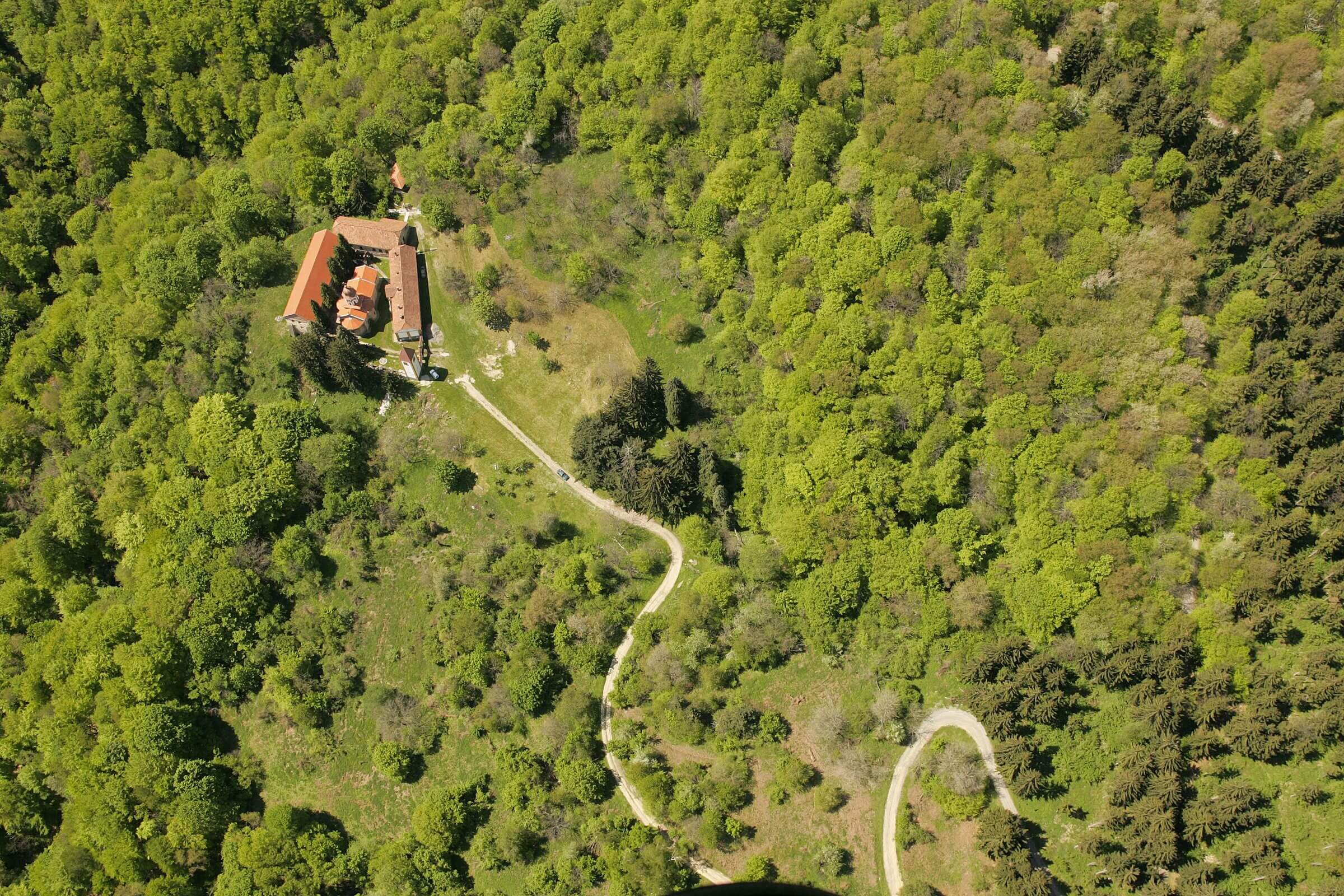
Papuk (photo credit: Mario Romulić)
To conclude this list, we need to shoutout few honorable mentions that definitely deserve their own article: off-road routes of Virovitica - Podravina County, muddy, exciting forest roads around rivers, sunny fields of Podravina, and glimpses of Western Slavonia, which has probably one of the best bike trails in Croatia. Pannonian bike roads pass through the calm landscapes, across the hills, through the woods and fields, along rivers, streams, and lakes. With the wind on your face, definitely discover the beauty of Pannonian cycling trails. For more details, check here.
Slavonski Brod and Brod-Posavina County with a must-visit to the monumental Brod Fortress, the largest of continental Croatia with its unique Tambura Museum. Posavina villages of Klakar, Donja, and Gornja Bebrina offer even more pleasures and forests that express the greenest places in Slavonia. Lipik, Pakrac and their Lipizzaner and Kuna Trail... What are you waiting for? For more details, check counties official website.
After an exhaustive analysis that can reach five more such articles, it’s only left of us to invite you and visit these beautiful places. From Požega to Ilok, these truly are one of the best bike tours in Slavonia, but not just that - in Croatia as well. For more cycling articles, visit our dedicated website.
For more, check out our lifestyle section.


